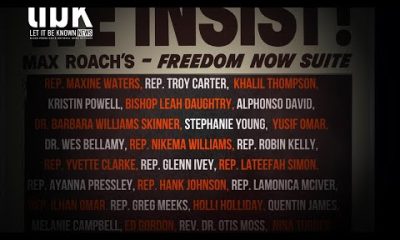#NNPA BlackPress
Inaugural Honeyland Festival Lays the Foundation for a Sweet Future
ABOVE: Lenora performs onstage during Honeyland Festival Day 2 (Photo by Medron White) This weekend saw the first showcase of Honeyland, a festival dedicated to music, food, and libations in Sugar Land. The festival boasted appearances from musical artists like Mary J. Blige, Miguel, Tems, Chlöe, Tobe Nwigwe, and Lucky Daye; culinary craftspeople like Marcus […]
The post Inaugural Honeyland Festival Lays the Foundation for a Sweet Future first appeared on BlackPressUSA.


ABOVE: Lenora performs onstage during Honeyland Festival Day 2 (Photo by Medron White)
This weekend saw the first showcase of Honeyland, a festival dedicated to music, food, and libations in Sugar Land. The festival boasted appearances from musical artists like Mary J. Blige, Miguel, Tems, Chlöe, Tobe Nwigwe, and Lucky Daye; culinary craftspeople like Marcus Samuelsson, Amaris Jones, Ghetto Gastro, and Chris Williams; and representatives from the beverage world like Fawn Weaver, Andre Hueston Mack, and Ben Williams. The festival also had appearances from Bun B and Kelis, two people that have leveraged their music careers to gain strong footholds in the food industry with Kelis becoming a classically trained chef and Bun B helming the wildly popular Trill Burgers. The two epitomize what the festival is about: reaching the masses through food and music.
The thing that the festival absolutely got right, was the music. For whatever reason, it’s usually a challenge getting a festival off the ground in the Bayou City but the lineup for Honeyland was promising. Even after Jazmine Sullivan bowed out of the festival, Summer Walker was quickly booked. Miguel closed out night one and Mary ended the second night but both days were packed with Hip-Hop and R&B.

Summer Walker performs onstage during Honeyland Festival Day 1 (Photo by Medron White)
While night one was chilly and day two was plagued by rain, it didn’t stop the performances. Houston’s own, Lenora, stunned with an electrifying performance and Coco Jones didn’t let the weather stop her, belting out SWV’s “Rain” as the sky opened up seemingly at her command.
“I came to see Lucky Daye,” said attendee Melisa Moore as she made her way towards the vendors after the singer performed his hit “Over.” “As long as I saw him, I got my money’s worth. Everything else was a bonus.”
The list of stars is just what a starting festival would need, bringing in fans from different parts of the country to the city. The show also struck a nice balance between Houston artists and guests from outside of the city with Lenora, Dende, Inayah, Tobe Nwigwe, Lil’ Keke, Paul Wall, Scarface, Slim Thug, and Z-Ro all hailing from Houston. And while shows like this are usually multistage events showcasing musical talent, Honeyland’s multi stages were split between music and food. The covered food stage gave chefs and bartenders the opportunity to display their skills for the live audience.
The transportation was also done right. While there was plenty of lot space in the Crown Festival Park, the entrance was almost guaranteed to be a traffic jam. If you’ve ever been to a festival, you know the headache that can occur getting people in and out the lots and Honeyland seemed to largely avoid that. Having people park at separate locations and being bussed in made moving in and out of the park more convenient.
The pieces were absolutely in place for a successful festival, but everything didn’t connect perfectly just yet. For instance, it’s a food festival, and while there were a number of vendors offering good eats, there weren’t enough to stop lines from being excessively long. Trill Burgers’ line was long but that should be expected at this point with everyone still trying to get their first taste of the award-winning offering by Bun B.
That all being said, a couple of tweaks like more food offerings and culinary showcases focused on attendees tasting the food would turn a truly great concert series into the music and culinary festival that it has all the potential to be. Fingers crossed that Honeyland will return to the city next year!

LeToya Luckett speaks during Honeyland Festival Day 1 (Photo by Medron White)

Chlöe performs onstage during Honeyland Festival Day 1 (Photo by Medron White)

Martica “Fat” Nwigwe and Tobe Nwigwe perform onstage during Honeyland Festival Day 1 (Photo by Medron White)

Miguel performs onstage during Honeyland Festival Day 1 (Photo by Medron White)

Festivalgoers attend Honeyland Festival Day 1 (Photo by Medron White)

Festivalgoers attend Honeyland Festival Day 1 (Photo by Medron White)

Lenora performs onstage during Honeyland Festival Day 2 (Photo by Medron White)

DJ Mr. Rogers performs onstage during Honeyland Festival Day 2 (Photo by Medron White)

Coco Jones performs onstage during Honeyland Festival Day 2 (Photo by Medron White)

Lucky Daye performs onstage during Honeyland Festival Day 2 (Photo by Medron White)

Tems performs onstage during Honeyland Festival Day 2 (Photo by Medron White)

Z-Ro performs onstage during Honeyland Festival Day 2 (Photo by Medron White)

Slim Thug performs onstage during Honeyland Festival Day 2 (Photo by Medron White)

Paul Wall performs onstage during Honeyland Festival Day 2 (Photo by Medron White)

Mary J. Blige performs onstage during Honeyland Festival Day 2 (Photo by Medron White)

Crowd during Honeyland Festival Day 2 (Photo by Medron White)
The post Inaugural Honeyland Festival Lays the Foundation for a Sweet Future appeared first on Forward Times.
The post Inaugural Honeyland Festival Lays the Foundation for a Sweet Future first appeared on BlackPressUSA.
#NNPA BlackPress
Remembering George Floyd
#NNPA BlackPress
OP-ED: Oregon Bill Threatens the Future of Black Owned Newspapers and Community Journalism
BLACKPRESSUSA NEWSWIRE — Nearly half of Oregon’s media outlets are now owned by national conglomerates with no lasting investment in local communities. According to an OPB analysis, Oregon has lost more than 90 news jobs (and counting) in the past five years. These were reporters, editors and photographers covering school boards, investigating corruption and telling community stories, until their jobs were cut by out-of-state corporations.

By Dr. Benjamin F. Chavis, Jr.
President and CEO, National Newspaper Publishers Association
For decades, The Skanner newspaper in Portland, the Portland Observer, and the Portland Medium have served Portland, Oregon’s Black community and others with a vital purpose: to inform, uplift and empower. But legislation now moving through the Oregon Legislature threatens these community news institutions—and others like them.
As President and CEO of the National Newspaper Publishers Association (NNPA), which represents more than 255 Black-owned media outlets across the United States—including historic publications like The Skanner, Portland Observer, and the Portland Medium—l believe that some Oregon lawmakers would do more harm than good for local journalism and community-owned publications they are hoping to protect.
Oregon Senate Bill 686 would require large digital platforms such as Google and Meta to pay for linking to news content. The goal is to bring desperately needed support to local newsrooms. However, the approach, while well-intentioned, puts smaller, community-based publications at a future severe financial risk.
We need to ask – will these payments paid by tech companies benefit the journalists and outlets that need them most? Nearly half of Oregon’s media outlets are now owned by national conglomerates with no lasting investment in local communities. According to an OPB analysis, Oregon has lost more than 90 news jobs (and counting) in the past five years. These were reporters, editors, and photographers covering school boards, investigating corruption, and telling community stories, until their jobs were cut by out-of-state corporations.
Legislation that sends money to these national conglomerate owners—without the right safeguards to protect independent and community-based outlets—rewards the forces that caused this inequitable crisis in the first place. A just and inclusive policy must guarantee that support flows to the front lines of local journalism and not to the boardrooms of large national media corporations.
The Black Press exists to fill in the gaps left by larger newsrooms. Our reporters are trusted messengers. Our outlets serve as forums for civic engagement, accountability and cultural pride. We also increasingly rely on our digital platforms to reach our audiences, especially younger generations—where they are.
We are fervently asking Oregon lawmakers to take a step back and engage in meaningful dialogue with those most affected: community publishers, small and independent outlets and the readers we serve. The Skanner, The Portland Observer, and The Portland Medium do not have national corporate parents or large investors. And they, like many smaller, community-trusted outlets, rely on traffic from search engines and social media to boost advertising revenue, drive subscriptions, and raise awareness.
Let’s work together to build a better future for Black-owned newspapers and community journalism that is fair, local,l and representative of all Oregonians.
Dr. Benjamin F. Chavis Jr., President & CEO, National Newspaper Publishers Association
#NNPA BlackPress
Hate and Chaos Rise in Trump’s America
BLACKPRESSUSA NEWSWIRE — Tactics ranged from local policy manipulation to threats of violence. The SPLC documented bomb threats at 60 polling places in Georgia, traced to Russian email domains.

By Stacy M. Brown
Black Press USA Senior National Correspondent
The Southern Poverty Law Center has identified 1,371 hate and antigovernment extremist groups operating across the United States in 2024. In its latest Year in Hate & Extremism report, the SPLC reveals how these groups are embedding themselves in politics and policymaking while targeting marginalized communities through intimidation, disinformation, and violence. “Extremists at all levels of government are using cruelty, chaos, and constant attacks on communities and our democracy to make us feel powerless,” said SPLC President Margaret Huang. The report outlines how hard-right groups aggressively targeted diversity, equity, and inclusion (DEI) initiatives throughout 2024. Figures on the far right falsely framed DEI as a threat to white Americans, with some branding it a form of “white genocide.” After the collapse of Baltimore’s Francis Scott Key Bridge, a former Utah legislator blamed the incident on DEI, posting “DEI = DIE.”
Tactics ranged from local policy manipulation to threats of violence. The SPLC documented bomb threats at 60 polling places in Georgia, traced to Russian email domains. Similar threats hit Jewish institutions and Planet Fitness locations after far-right social media accounts attacked them for trans-inclusive policies. Telegram, which SPLC describes as a hub for hate groups, helped extremists cross-recruit between neo-Nazi, QAnon, and white nationalist spaces. The platform’s lax moderation allowed groups like the Terrorgram Collective—designated terrorists by the U.S. State Department—to thrive. Militia movements were also reorganized, with 50 groups documented in 2024. Many, calling themselves “minutemen,” trained in paramilitary tactics while lobbying local governments for official recognition. These groups shared personnel and ideology with white nationalist organizations.
The manosphere continued to radicalize boys and young men. The Fresh & Fit podcast, now listed as a hate group, promoted misogyny while mocking and attacking Black women. Manosphere influencers used social media algorithms to drive youth toward male-supremacy content. Turning Point USA played a key role in pushing white nationalist rhetoric into mainstream politics. Its leader Charlie Kirk claimed native-born Americans are being replaced by immigrants, while the group advised on Project 2025 and organized Trump campaign events. “We know that these groups build their power by threatening violence, capturing political parties and government, and infesting the mainstream discourse with conspiracy theories,” said Rachel Carroll Rivas, interim director of the SPLC’s Intelligence Project. “By exposing the players, tactics, and code words of the hard right, we hope to dismantle their mythology and inspire people to fight back.”
Click here for the full report or visit http://www.splcenter.org/resources/guides/year-hate-extremism-2024.
-

 Activism4 weeks ago
Activism4 weeks agoAI Is Reshaping Black Healthcare: Promise, Peril, and the Push for Improved Results in California
-

 Activism4 weeks ago
Activism4 weeks agoBarbara Lee Accepts Victory With “Responsibility, Humility and Love”
-

 Activism4 weeks ago
Activism4 weeks agoESSAY: Technology and Medicine, a Primary Care Point of View
-

 Activism4 weeks ago
Activism4 weeks agoFaces Around the Bay: Author Karen Lewis Took the ‘Detour to Straight Street’
-

 Arts and Culture4 weeks ago
Arts and Culture4 weeks agoBOOK REVIEW: Love, Rita: An American Story of Sisterhood, Joy, Loss, and Legacy
-

 Activism4 weeks ago
Activism4 weeks agoNewsom Fights Back as AmeriCorps Shutdown Threatens Vital Services in Black Communities
-

 #NNPA BlackPress4 weeks ago
#NNPA BlackPress4 weeks agoThe RESISTANCE – FREEDOM NOW
-

 Activism4 weeks ago
Activism4 weeks agoTeachers’ Union Thanks Supt. Johnson-Trammell for Service to Schools and Community















































